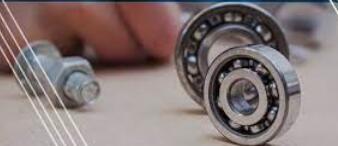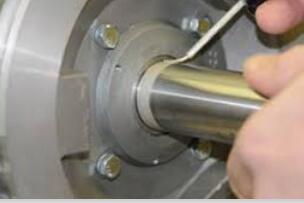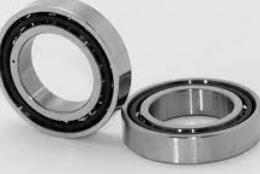Bearing Maintenance and Replacement: Best Practices
Get ready to keep your bearings spinning smoothly!
From identifying common issues to mastering cleaning techniques, we'll show you how to keep your machinery running like new.
So, kick back, relax, and get ready to become a bearing maintenance pro with our cheerful guide!
Hello and welcome to our guide on bearing maintenance and replacement!
Are you ready to learn how to keep your bearings spinning smoothly?
Whether you're a seasoned pro or just starting, our cheerful guide will show you the best practices for maintaining and replacing bearings.
From identifying common issues to mastering cleaning techniques, we'll provide you with all the tools you need to ensure your machinery runs like new.
So, let's dive in and get started on the path to becoming a bearing maintenance expert!
Best practices in bearing maintenance and replacement:
-Regularly inspect bearings for signs of wear or damage.
-Properly lubricate bearings according to manufacturer recommendations.
-Use the correct type and amount of lubricant.
-Protect bearings from contamination and moisture.
-Monitor bearing temperature to detect potential problems.
-Handle bearings carefully during installation to prevent damage.
-Replace bearings when they show signs of wear or damage.
-Use high-quality replacement bearings from a reputable supplier.
-Ensure proper fit and alignment during installation.
Our guide is here to help you breeze through it with ease.
We'll cover everything from proper lubrication to ensuring the correct fit, so you can avoid common issues and keep your machinery running smoothly.
So why wait?
Dive into our comprehensive guide on bearing maintenance and replacement and discover the best practices that will keep your bearings spinning for years to come!
Bearing Maintenance Best Practices

Proper lubrication techniques
The use of appropriate lubricants is crucial for the optimal performance and longevity of bearings.
Proper lubrication reduces friction and wear and helps protect against contamination and corrosion.
It is important to use the correct type of lubricant in the right amount and at the right intervals.
Lubricant selection should be based on the operating conditions and manufacturer recommendations.
Regular cleaning and inspection
Regular inspection and cleaning can help prevent bearing failure by identifying early signs of damage or wear.
During inspections, it is important to check for any visible wear, heat discoloration, or pitting.
Cleanliness is also key to bearing performance, as contaminants can cause damage and reduce lifespan.
Remember to follow manufacturer guidelines when cleaning bearings.
Monitoring vibration and temperature
Monitoring vibration and temperature can provide valuable insights into the health of a bearing.
Unusual vibration or temperature changes are often indicative of a problem such as a misalignment, imbalance, or lack of lubrication.
Regular monitoring can help detect these issues early and prevent catastrophic failures.
Correct installation and handling
Proper installation and handling of bearings are critical to their performance and longevity.
Bearings should always be handled carefully and installed correctly with the correct tools.
Improper installation can lead to premature bearing failure and expensive downtime.
Maintaining appropriate operating conditions
It is important to maintain appropriate operating conditions for bearings to ensure optimal performance and longevity.
This includes maintaining proper lubrication, avoiding overloading, ensuring correct alignment, and keeping the bearings clean and free of contaminants.
Operating outside of recommended parameters can lead to premature wear and reduced lifespan.
By following these bearing maintenance best practices, you can extend the life of your bearings and avoid costly downtime due to unexpected failures.
Bearing Replacement Best Practices

Identifying signs of wear and damage
Knowing when to replace a bearing is key to preventing catastrophic failure and costly downtime.
Signs of wear and damage can include abnormal noise or vibration, heat discoloration, cracking, or visible wear on the bearing surface.
Regular inspection and monitoring can help detect early signs of wear and damage.
Proper removal techniques to avoid further damage
Removing a worn or damaged bearing without causing further damage is crucial.
The use of proper tools and techniques is important to prevent damage to the bearing housing or shaft.
Heat application, press fit, and puller systems are all commonly used techniques for removing bearings.
Choosing the correct replacement bearing
Selecting the right replacement bearing is vital to ensuring optimal performance.
When selecting a replacement bearing, it is important to consider factors such as load capacity, speed rating, operating conditions, and lubrication requirements.
Always refer to the manufacturer's recommendations for proper selection.
Correct installation techniques
Proper installation is critical to the longevity and performance of a bearing.
The bearing should be installed with the correct tools and techniques to ensure proper fit and alignment.
Improper installation can lead to premature bearing failure and expensive downtime.
Always refer to the manufacturer's guidelines for proper installation.
By following these bearing replacement best practices, you can maintain the optimal performance and longevity of your machinery.
Remember to regularly inspect your bearings for signs of wear or damage and to always refer to the manufacturer's recommendations for proper maintenance and replacement.
Common Mistakes to Avoid

Over-greasing or under-greasing
Over-greasing can lead to excess heat and friction, which can cause premature bearing failure.
On the other hand, under-greasing can cause damage due to a lack of lubrication.
It's important to properly grease bearings according to manufacturer recommendations and to use the correct type and amount of lubricant.
Incorrect installation or handling
Improper installation or handling can cause damage to bearings, which can lead to premature failure.
Always refer to the manufacturer's guidelines for proper installation and handling techniques, such as using the correct tools,
checking fit and alignment, and protecting the bearing from contaminants.
Neglecting routine maintenance
Neglecting routine maintenance, such as regular inspection and cleaning, can lead to a variety of issues, including contamination, wear, and damage.
Regular maintenance can help you detect early signs of wear or damage and prevent costly downtime due to bearing failure.
Using incorrect bearings
Using the incorrect type or size of bearing can result in premature wear or damage.
When selecting replacement bearings, it's important to consider factors such as load capacity, speed rating, and operating conditions.
Always refer to the manufacturer's recommendations for proper selection.
By avoiding these common mistakes, you can ensure optimal performance and longevity of your bearings.
Remember to follow manufacturer guidelines for proper maintenance, installation, and selection of bearings.
Tools and Resources for Bearing Maintenance and Replacement
Recommended lubricants and cleaners
Using the correct type and amount of lubricant is crucial to the optimal performance and longevity of bearings.
Manufacturers often recommend specific lubricants and cleaners to use with their bearings.
It's important to follow these recommendations to ensure proper lubrication and cleanliness.
Vibration monitoring tools
Vibration monitoring can provide valuable insights into the health of a bearing.
Tools such as vibration meters or analyzers can detect unusual vibration patterns or frequencies that may indicate problems such as misalignment, imbalance, or lack of lubrication.
Regular vibration monitoring can help detect these issues early and prevent catastrophic failure.
Bearing selection guides and technical manuals
Manufacturers often provide selection guides and technical manuals to help users select and maintain bearings.
These resources may include information on load capacity, speed rating, operating conditions, lubrication requirements, and installation techniques.
Consulting these resources can help ensure the correct selection, installation, and maintenance of your bearings.
By using these tools and resources, you can improve the performance and longevity of your bearings.
Remember to always follow manufacturer recommendations and guidelines for proper maintenance and replacement of bearings.
Training and Education for Optimal Bearing Maintenance and Replacement
Educating personnel on best practices for bearing maintenance and replacement is crucial to ensuring optimal performance and longevity of machinery.
Proper maintenance practices can prevent unnecessary downtime, reduce repair costs, and extend the lifespan of bearings.
It's important for personnel to be trained on the following topics:
1.Proper lubrication techniques:Understanding the importance of lubrication and how to properly lubricate bearings is key to maintaining optimal performance.
2.Regular cleaning and inspection:Regular inspection and cleaning can help prevent bearing failure by identifying early signs of damage or wear.
3.Monitoring vibration and temperature:Monitoring vibration and temperature can provide valuable insights into the health of a bearing.
4.Correct installation and handling:Proper installation and handling of bearings are critical to their performance and longevity.
5.Identifying signs of wear and damage:Knowing when to replace a bearing is key to preventing catastrophic failure and costly downtime.
Training programs and resources are available to help educate personnel on best practices for bearing maintenance and replacement.
These resources may include online courses, instructional videos, and technical manuals from bearing manufacturers.
By providing proper training and resources, organizations can ensure that personnel has the knowledge and skills necessary to properly maintain bearings and optimize machine performance.
Educating personnel on best practices for bearing maintenance and replacement is crucial to ensuring optimal performance and longevity of machinery.
Training programs and resources are available to help personnel learn proper maintenance practices and improve overall machine performance.
Conclusion
In conclusion, following best practices for bearing maintenance and replacement is crucial to ensuring optimal performance and longevity of machinery.
Proper maintenance practices can prevent unnecessary downtime, reduce repair costs, and extend the lifespan of bearings.
Educating personnel on best practices and providing training programs and resources is essential to achieving these goals.
By following these best practices, you can be confident that your bearings will continue to spin smoothly for years to come.





